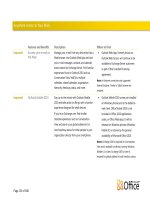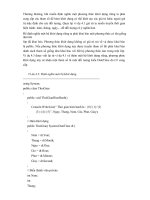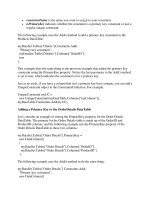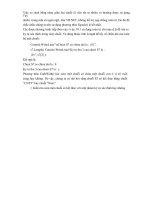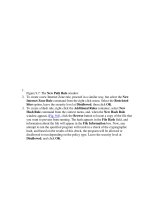Microsoft ® Office 2010 Simply Phần 2 pptx
Bạn đang xem bản rút gọn của tài liệu. Xem và tải ngay bản đầy đủ của tài liệu tại đây (4.71 MB, 42 trang )
29
CHAPTER
3
OFFICE FEATURES
66
Can I search for a particular type of
media?
Yes. To search for, say, a photo or sound
file, click the Results should be
and
select from the list of media types that
appears. Alternatively, leave All media file
types selected to search for a match among
all available media formats.
How do I find details about the clip art?
To find out more about a piece of clip art,
position the
over it in the Clip Art task
pane, click the
, and then click Preview/
Properties. The Preview/Properties dialog
box opens, displaying the file’s size, name,
type, creation date, and more.
Office Graphics Tools
•
The clip art is inserted into
the file.
•
The Picture tools appear on
the Format tab.
You can resize or move the
clip art.
Note: See the “Resize and Move
Objects” section, later in this
chapter, to learn more.
To deselect the clip art, you
can click anywhere else in the
work area.
•
You can click to close the
pane.
The Clip Art task pane displays
any matches for the keyword
or phrase that you typed.
•
You can use the scroll bar to
move through the list of
matches.
6 To add a clip art image, click
the image.
06_571941-ch03.indd 2906_571941-ch03.indd 29 4/9/10 7:41 PM4/9/10 7:41 PM
30
11
44
33
22
The Insert Picture dialog box
appears.
4 Navigate to the folder or drive
containing the image file that
you want to use.
•
To browse for a particular file
type, you can click the
and
choose a file format.
1 Click the area where you want
to add a picture.
You can move the image to a
different location after
inserting it onto the page.
2 Click the Insert tab.
3 In the Illustrations group, click
Picture.
Insert a Picture
In addition to using clip art to add punch to
your Office files, you can illustrate your files
with images that you store on your computer.
For example, if you have a photo or graphic file
that relates to your Excel data, you can insert it
onto the worksheet. After you insert an image,
you can resize, reposition, rotate, and flip it.
You can also perform other types of edits on
the image, such as cropping, image correction,
color correction, and more. Office 2010 also
includes several tools, sometimes called filters,
for applying artistic effects to images you insert
in files.
Insert a
Picture
06_571941-ch03.indd 3006_571941-ch03.indd 30 4/9/10 7:41 PM4/9/10 7:41 PM
31
Office Graphics Tools
CHAPTER
3
OFFICE FEATURES
66
55
Can I compress images to save space?
Yes. To compress an image that you add
to an Office file, click the image, click the
Format tab on the Ribbon, and click the
Compress Pictures button (
) in the
Adjust group. Adjust settings as needed
in the Compress Pictures dialog box and
click OK.
Can I undo changes to my picture?
Yes. Click the Reset Picture button
(
), located in the Adjust group on
the Format tab, to restore the selected
picture to its original state. (Note that
activating this command does not
restore the image to its original size.)
•
The picture is added to the
file.
•
The Picture tools appear on
the Format tab.
You may need to resize or
reposition the picture to fit
the space.
Note: See the “Resize and Move
Objects” section to learn more.
To remove a picture that you
no longer want, you can click
the picture and press
Delete
.
5 Click the file you want to add.
6 Click Insert.
Note: Image files, also called
objects, come in a variety of
file formats, including GIF, JPEG,
and PNG.
06_571941-ch03.indd 3106_571941-ch03.indd 31 4/9/10 7:42 PM4/9/10 7:42 PM
32
11
33
22
•
When you release the mouse
button, the object is resized.
Resize an Object
1 Click the object that you want
to resize.
2 Click a selection handle.
3 Drag inward or outward to
resize the object.
Note: To maintain an object’s
height-to-width ratio when
resizing, drag one of the
corner handles.
Resize and Move Objects
Clip art and other types of images, such as
smart art and word art (discussed later in this
chapter), are called objects. When you insert an
object, such as an image, into an Office file,
you may find that you need to make it larger
or smaller in order to achieve the desired
effect. Fortunately, doing so is easy. When
you select an object in an Office file, handles
appear around that object; you can use these
handles to make the object larger or smaller.
You can also move objects that you place in
a file.
Resize and
Move Objects
06_571941-ch03.indd 3206_571941-ch03.indd 32 4/9/10 7:42 PM4/9/10 7:42 PM
33
Office Graphics Tools
CHAPTER
3
OFFICE FEATURES
11
22
How can I wrap text around an object?
If you insert an object into a Word or Publisher file, you can control
how text in the file wraps around the object. For example, you may
want the text to wrap tightly around a clip art graphic; alternatively,
you might prefer for the text to overlap an image. Regardless of your
preferences, you can establish text-wrapping settings by clicking the
object, clicking the Text Wrapping button in the Format tab, and
choosing a wrap style (
•
).
•
When you release the mouse
button, the object moves to
the new location.
Note: You can also move an
object by cutting it from its
current location and pasting it in
the desired spot. For help, refer
to the section “Cut, Copy, and
Paste Data” in Chapter 2.
Move an Object
1 Click the object that you want
to move.
2 Drag the object to a new
location on the worksheet.
06_571941-ch03.indd 3306_571941-ch03.indd 33 4/9/10 7:42 PM4/9/10 7:42 PM
34
11
22
•
When you release the mouse,
the object rotates.
Note: You can also use the
Rotate button (
) on the
Format tab on the Ribbon to
rotate an object 90 degrees
left or right.
Rotate an Object
1 Click the object that you want
to rotate.
•
A rotation handle appears on
the selected object.
2 Click and drag the handle to
rotate the object.
Rotate and Flip Objects
After you insert an object such as a piece of clip
art or a photo from your hard drive into a Word
document, an Excel worksheet, a PowerPoint
slide, or a Publisher brochure, you may find
that the object appears upside down or
inverted. To rectify this, you can rotate or flip
the object. For example, you might flip a clip
art image to face another direction, or rotate
an arrow object to point elsewhere on the
page. Alternatively, you might rotate or flip
an object that you place in an Office 2010 file
simply to change the appearance of that
object.
Rotate and
Flip Objects
06_571941-ch03.indd 3406_571941-ch03.indd 34 4/9/10 7:42 PM4/9/10 7:42 PM
35
Office Graphics Tools
CHAPTER
3
OFFICE FEATURES
11
22
33
•
The object flips.
Flip an Object
1 Click the object that you want
to flip.
The Format tab opens and
displays the Picture tools.
2 Click the Rotate button ( )
on the Format tab.
3 Click Flip Vertical or Flip
Horizontal.
How do I rotate text?
The easiest way to rotate text is to first
insert the text as a WordArt object (see
the upcoming section “Create a
WordArt Object” for details). After the
text has been inserted as a WordArt
object, you can rotate it as you would
any other object.
Can I constrain the rotation?
Yes. To constrain the rotation to
15-degree increments, press and hold
while using the rotation handle to
rotate the object. Alternatively, rotate the
object in 90-degree increments by clicking
the Rotate button (
) on the Format tab
and choosing Rotate Right 90° or
Rotate Left 90°.
06_571941-ch03.indd 3506_571941-ch03.indd 35 4/9/10 7:42 PM4/9/10 7:42 PM
36
11
22
•
Crop handles surround the
image.
1 Click the image that you
want to edit.
•
The Format tab opens and
displays the Picture tools.
2 Click the Crop button.
Crop a Picture
In addition to resizing an Office object, such as
a clip art image or a photo you have stored on
your computer’s hard drive, you can use the
Crop tool to crop it. When you crop an object,
you remove vertical and/or horizontal edges
from the object. For example, you might use
the Crop tool to create a better fit, to omit a
portion of the image, or to focus the viewer on
an important area of the image. The Crop tool
is located on the Format tab on the Ribbon,
which appears when you click the object you
want to crop.
Crop a
Picture
06_571941-ch03.indd 3606_571941-ch03.indd 36 4/9/10 7:42 PM4/9/10 7:42 PM
37
Office Graphics Tools
CHAPTER
3
OFFICE FEATURES
44
33
Are there other cropping options?
In addition to cropping your objects into square
or rectangular shapes, you can crop your objects
using one of any number of predefined shapes.
These predefined shapes include ovals, triangles,
hearts, moons, arrows, and more. To access these
additional cropping options, click the object you
want to crop to select it, click the Format tab
that appears on the Ribbon, click the down arrow
under the Crop button, click Crop to Shape, and
choose the desired shape from the menu that
appears.
4 Click outside the image to
finalize the crop operation.
Note: See the “Resize and Move
Objects” section, earlier in this
chapter, to learn how to resize
an image.
3 Click and drag a crop handle
to crop out an area of the
image.
When you release the mouse
button, the image is cropped.
06_571941-ch03.indd 3706_571941-ch03.indd 37 4/9/10 7:42 PM4/9/10 7:42 PM
38
44
11
22
33
1 Click the picture that you want
to edit.
The Format tab appears on the
Ribbon with the Picture tools
shown.
2 In the Picture Styles group,
click the Picture Effects
button.
3 Click an effect category.
4 Click an effect style.
•
As you drag over each effect in
the menu, the picture displays
what the effect looks like when
you apply it.
•
The new effect is applied to
the picture.
Note: To cancel any picture
effect, display the Picture Effects
menu again and the style that
you applied, and then select the
No option at the top of the
category palette to remove the
effect.
Add a Picture Effect
You can use the Picture Effect tool included
with many Office 2010 programs to assign
unique and interesting special effects to your
objects. For example, you can apply a shadow
effect, create a mirrored reflection, apply a
glow effect, soften the object’s edges, make a
bevel effect, or generate a 3D rotation effect.
You access the Picture Effects tools from the
Format tab on the Ribbon; this tab appears
when you click to select the object to which you
want to apply the effect. (Note that that the
Picture Effects tool is not available in Publisher.)
Add a Picture
Effect
06_571941-ch03.indd 3806_571941-ch03.indd 38 4/9/10 7:42 PM4/9/10 7:42 PM
39
CHAPTER
3
11
33
22
1 Click the picture that you want
to edit.
The Format tab appears on the
Ribbon with the Picture tools
shown.
2 In the Adjust group, click the
Corrections button.
•
Office highlights the image’s
current correction settings.
•
As you drag over each setting
in the menu, the picture
displays what the setting looks
like when you apply it.
3 Click a correction setting.
•
The new setting is applied to
the picture.
Make Image Corrections
Suppose the image object you have inserted in
your Word, Excel, or PowerPoint file is less than
perfect. Perhaps it is slightly blurry, or lacks
contrast. Fortunately, Office 2010 offers tools
that enable you to make corrections to clip art
and images even after they have been inserted
into your file. For example, you can sharpen
and soften images, as well as adjust their
brightness and contrast. You access the image-
correction tools from the Format tab on the
Ribbon; this tab appears when you click to
select the object to which you want to apply
the effect.
Make Image
Corrections
06_571941-ch03.indd 3906_571941-ch03.indd 39 4/9/10 7:42 PM4/9/10 7:42 PM
40
11
22
33
•
The new setting is applied to
the picture.
1 Click the picture that you want
to edit.
The Format tab appears on the
Ribbon with the Picture tools
shown.
2 In the Adjust group, click the
Color button.
•
Office highlights the image’s
current color settings.
•
As you drag over each setting
in the menu, the picture
displays what the setting looks
like when you apply it.
3 Click a color setting.
Make Color Adjustments
If you find that the color in an image you insert
in an Office 2010 file seems off, you can adjust
it using the Office 2010 Color Saturation, Color
Tone, and Recolor tools. The Color Saturation
tool enables you to make the color in your
image more or less intense; the Color Tone tool
enables you to make the colors in your image
appear warmer or cooler; and the Recolor tool
enables you to apply a color cast to your
image. You can also use these tools to apply
artistic effects to an image, such as converting
a color image to black and white.
Make Color
Adjustments
06_571941-ch03.indd 4006_571941-ch03.indd 40 4/9/10 7:42 PM4/9/10 7:42 PM
41
CHAPTER
3
11
22
33
1 Click the picture that you want
to edit.
The Format tab appears on the
Ribbon with the Picture tools
shown.
2 In the Adjust group, click the
Artistic Effects button.
•
Office highlights the image’s
current effect.
•
As you drag over each effect in
the menu, the picture displays
what the effect looks like when
you apply it.
3 Click an artistic effect.
Apply Artistic Effects
Office 2010 includes several tools, sometimes
referred to as filters, for applying artistic effects
to images and clip art in order to liven them
up. For example, you can apply an artistic
effect to an image to make that image appear
as though it was rendered in marker, pencil,
chalk, or paint. Applying certain other filters
creates an effect reminiscent of mosaics, film
grain, or glass. You access these artistic effects
from the Format tab on the Ribbon; this tab
appears when you click to select the object to
which you want to apply the effect.
Apply Artistic
Effects
•
The new effect is applied to
the picture.
06_571941-ch03.indd 4106_571941-ch03.indd 41 4/9/10 7:42 PM4/9/10 7:42 PM
42
44
22
33
11
•
Office converts the selected
text to an object, applies the
WordArt option you selected,
and opens the Format tab with
various Office drawing tools
shown.
1 After typing the text you want
to convert to a WordArt object,
select the text.
2 Click the Insert tab.
3 In the Text group, click
WordArt.
4 Click a WordArt option.
Create a WordArt Object
You can use the WordArt feature to turn text
into interesting graphic objects to use in your
Office files. For example, you can create arched
text to appear over a range of data in Excel, or
vertical text to appear next to a paragraph in
Word. You can create text graphics that bend
and twist, or display a subtle shading of color.
You access the various WordArt options from
the Insert tab on the Ribbon. After you convert
text into a WordArt object, you can resize,
move, rotate, and flip that object just as you
would any other object in Office.
Create a
WordArt Object
06_571941-ch03.indd 4206_571941-ch03.indd 42 4/9/10 7:42 PM4/9/10 7:42 PM
43
Office Graphics Tools
CHAPTER
3
OFFICE FEATURES
55
66
77
How do I edit my WordArt text?
To edit WordArt text, simply click the
WordArt text box, select the text that
you want to change, and type over it.
To edit the appearance of the WordArt
object, use the WordArt Styles tools,
located on the Format menu on the
Ribbon.
How do I remove a WordArt object?
To remove a WordArt object from your
Office file, click the WordArt text box
and then press
Delete
. Alternatively,
click the WordArt text box, click the
Quick Styles button in the Format tab,
and click Clear Word Art. The
WordArt object disappears.
•
The WordArt object is
transformed.
You can resize or move the
image.
Note: See the section “Resize
and Move Objects” to learn
more.
•
You can click the Quick Styles
button to change the text
style.
•
You can click these buttons to
change the text outline color
(
) and text fill color ( ).
5 Click the Text Effects
button (
).
6 Click Transform.
7 Click a transform style.
06_571941-ch03.indd 4306_571941-ch03.indd 43 4/9/10 7:42 PM4/9/10 7:42 PM
44
11
22
33
44
55
66
The Choose a SmartArt Graphic
dialog box appears.
4 Click a category.
5 Click a chart style.
6 Click OK.
1 Click in your file where you
want to insert the diagram.
2 Click the Insert tab.
3 Click the SmartArt button.
Add SmartArt
You can use the SmartArt feature to create all
kinds of diagrams to illustrate concepts and
processes in your Office files. For example, you
might insert a diagram in a document to show
the hierarchy in your company or to show the
workflow in your department.
Office 2010 includes several predefined
diagram types from which to choose, including
list, process, cycle, hierarchy, relationship,
matrix, pyramid, and picture. In addition, you
can choose from several diagram styles within
each type. For example, if you choose to create
a hierarchy diagram, you can choose from
several different styles of hierarchy diagrams.
Add
SmartArt
06_571941-ch03.indd 4406_571941-ch03.indd 44 4/9/10 7:42 PM4/9/10 7:42 PM
45
Office Graphics Tools
CHAPTER
3
OFFICE FEATURES
88
77
8 Continue typing text in each
diagram text box.
•
To add another text box and
element to the diagram, click
the Add Shape button.
•
To change the shape style,
click another shape from the
SmartArt Styles group.
The diagram and placeholder
text boxes appear, along with
the Text pane.
7 Click in a text box and type
the text for the item.
•
You can change the layout
here.
Can I resize my diagram?
Yes. You can move and resize a
diagram just like any other Office
object. To move or resize a
diagram, see the “Resize and
Move Objects” section. You can
also use the controls on the
Format tab to resize a diagram.
Can I change a shape’s position or
form?
Yes. To change the position, click the shape
and then click the Promote or Demote
button in the Create Graphic group on the
Design tab. To change the form, click the
shape, click the Format tab, and click the
Change Shape button in the Shapes group.
06_571941-ch03.indd 4506_571941-ch03.indd 45 4/9/10 7:42 PM4/9/10 7:42 PM
46
22
11
The Create a New Workspace
dialog box appears.
2 Click the type of workspace
you want to create.
1 After logging on to Office Live
Workspace in your Internet
browser, click the New
Workspace link under My
Workspaces.
Note: For help logging on to
Office Live Workspace, see the
first tip at the end of this section.
Create a New Workspace
You can use the Office Live Web site to store
and share your Office files. By default, Office
Live contains one predefined workspace, called
Documents, which you can use to store and
share files, but you can create additional
workspaces as needed. For example, you might
create a workspace devoted to a particular
project, a workspace for use with a specific
client, or different workspaces for use with
different members of your team. New
workspaces can be blank or based on a
template. When you create a workspace based
on a template, it includes various predefined
documents and other items.
Create a New
Workspace
07_571941-ch04.indd 4607_571941-ch04.indd 46 4/9/10 7:39 PM4/9/10 7:39 PM
47
CHAPTER
4
OFFICE FEATURES
44
33
Working with Office Files Online
4 Type a description for the new
workspace.
Office Live Workspace creates
a new workspace based on the
template you chose.
3 Type a name for the new
workspace.
How do I log on to Office Live
Workspace?
To use Office Live Workspace, you must
have a Windows Live account. To obtain
one, direct your Web browser to home.
live.com, click the Sign Up link, and
enter the requested information. Next,
direct your browser to workspace.office.
live.com, type your Windows Live ID and
password, and click Sign In.
What workspace templates are
available?
Office Live offers several workspace
templates, including Class, Event,
Household, Meeting, Project, and School.
Each template contains specific files. For
example, Household includes an
announcement board, an emergency
contact list, a grocery list, a household
event list, and a to-do list.
07_571941-ch04.indd 4707_571941-ch04.indd 47 4/9/10 7:39 PM4/9/10 7:39 PM
48
22
11
33
44
The Open dialog box appears.
3 Locate and select the file you
want to upload.
4 Click Open.
1 Click the workspace in which
you want to store the
uploaded file.
2 Click Add Documents.
Upload a File to Office Live Workspace
You can upload files that you have stored on
your hard drive to Office Live Workspace. Doing
so enables you to access the files from any
computer connected to the Internet. For
example, you might upload a file stored on the
hard drive of your work computer to Office Live
Workspace so that you can access it from your
home computer. In addition, when you upload
a file to Office Live Workspace, you can easily
share that file with others. You can store as
much as 5GB of files on Office Live Workspace.
Upload a File to
Office Live Workspace
07_571941-ch04.indd 4807_571941-ch04.indd 48 4/9/10 7:39 PM4/9/10 7:39 PM
49
Working with Office Files Online
CHAPTER
4
OFFICE FEATURES
Can I upload multiple files at once?
Yes. If you want to upload multiple files to a workspace at once, you can easily
do so. Simply click the Add Documents button in Office Live Workspace to
launch the Open dialog box. There, locate the folder containing the files you
want to upload to your workspace; then press
as you click each file you
want to include in the upload operation. Once all the desired files are selected,
click the Open button in the Open dialog box. Office Live Workspace uploads
the files.
•
The uploaded file appears as a
clickable link.
Office Live Workspace
uploads the file.
•
Office Live Workspace
indicates the progress of
the upload.
07_571941-ch04.indd 4907_571941-ch04.indd 49 4/9/10 7:39 PM4/9/10 7:39 PM
50
22
11
33
44
66
Office Live Workspace creates
a new file in the appropriate
program.
Note: You may be warned that
the file you have created may
be unsafe. Click the Enable
Editing button to proceed.
4 Enter your data in the file.
5 Click the file’s Close
button (
).
Office prompts you to save
your changes.
6 Click Save.
1 Click the workspace in
which you want to create
the new file.
2 Click New.
3 Click the type of file you want
to create (in this example,
Word document).
Create a New File in Office Live Workspace
In addition to uploading files to Office Live
Workspace from your computer, you can create
new Word documents, Excel spreadsheets, and
PowerPoint presentations from within Office
Live Workspace. In addition, you can create
new notes and lists, including task lists, contact
lists, and event lists. (As an aside, you can also
create folders in which to organize your files on
Office Live Workspace.)
To create new files from within Office Live
Workspace, you must first install the Office Live
Update on your computer. Click the Install
Office Live Update button in the Office Live
Workspace window to get started.
Create a New File in
Office Live Workspace
07_571941-ch04.indd 5007_571941-ch04.indd 50 4/9/10 7:39 PM4/9/10 7:39 PM
51
Working with Office Files Online
CHAPTER
4
OFFICE FEATURES
77
88
Is there a faster way to access Office Live Workspace?
Yes. If you use Internet Explorer as your Web browser, you can save any
workspace in Office Live Workspace as a favorite. Simply click the Favorites
button in the upper right corner of the Office Live Workspace window and click
Add in the dialog box that appears. Next time you want to access Office Live
Workspace, click the Favorites button in the upper left corner of your browser
window, click the Favorites tab in the pane that appears, and locate and click
the Office Live Workspace entry.
•
The file is saved in your Office
Live workspace.
The Save As dialog box
appears.
•
Your file is saved in your Office
Live workspace by default.
7 Type a name for your file.
8 Click Save.
07_571941-ch04.indd 5107_571941-ch04.indd 51 4/9/10 7:39 PM4/9/10 7:39 PM
52
22
11
44
33
•
The file opens in Office Live
Workspace.
3 Click the Edit button.
•
An Open Document dialog box
may appear, warning you that
you should open the file only
if it is from a trusted source.
Note: Alternatively, you may be
warned that the file you have
created may be unsafe. Click the
Enable Editing button to
proceed.
4 Click OK.
1 Click the workspace containing
the file you want to edit.
2 Click the link for the file to
open it.
Edit a File in Office Live Workspace
Suppose you have saved a Word document on
Office Live Workspace. You can open that
document within Word to edit it; then, when
you save the document, any changes you made
to it are visible in Office Live Workspace. The
same is true for Excel and PowerPoint files that
you have saved on Office Live Workspace.
Alternatively, you can open the file from within
Office Live Workspace, as described in this
section. When you do, Office Live Workspace
launches the appropriate program, enabling
you to make the necessary edits. When you
save the edits, the file is updated accordingly
on Office Live Workspace.
Edit a File in Office
Live Workspace
07_571941-ch04.indd 5207_571941-ch04.indd 52 4/9/10 7:39 PM4/9/10 7:39 PM
53
Working with Office Files Online
CHAPTER
4
OFFICE FEATURES
66
55
How do I view earlier versions of
a file?
Office Live Workspace maintains
multiple versions of files. To view
previous versions of a file, open the file
in Office Live Workspace, click the
Version menu, and click the version you
want to view from the list that appears.
What are the Office Live Web apps?
Office Web apps are free, scaled-down,
Web-based versions of certain
Microsoft Office programs. They
include the Word Web app, the Excel
Web app, and the PowerPoint Web
app. You access and use these apps
from within your Web browser.
•
Your edits appear in the file in
your Office Live workspace.
•
The file opens in the appropriate
Office program (in this
example, Microsoft Word).
5 Edit the file as desired.
6 Click the Save button ( ) in
the Quick Access toolbar.
Note: The Save button in the
Quick Access toolbar appears
different here because the file
you are working on is online.
7 Click the Close button ( ).
07_571941-ch04.indd 5307_571941-ch04.indd 53 4/9/10 7:39 PM4/9/10 7:39 PM


